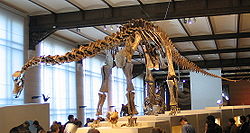Kaatedocus
|
Kaatedocus Temporal range: Late Jurassic, 155 Ma |
|
|---|---|
 |
|
| Mounted skeleton cast, Museum voor Natuurwetenschappen in Brussels, Belgium | |
| Scientific classification | |
| Kingdom: | Animalia |
| Phylum: | Chordata |
| Class: | Reptilia |
| Clade: | Dinosauria |
| Order: | Saurischia |
| Suborder: | †Sauropodomorpha |
| Clade: | †Neosauropoda |
| Family: | †Diplodocidae |
| Subfamily: | †Diplodocinae |
| Genus: |
†Kaatedocus Tschopp & Mateus, 2012 |
| Type species | |
|
†Kaatedocus siberi Tschopp & Mateus, 2012 |
|
Kaatedocus is a genus of diplodocine flagellicaudatan sauropod known from the middle Late Jurassic (Kimmeridgian stage) of northern Wyoming, United States. It is known from well-preserved skull and cervical vertebrae which were collected in the lower part of the Morrison Formation. The type and only species is Kaatedocus siberi, described in 2012 by Emanuel Tschopp and Octávio Mateus.
In 1934, a team of the American Museum of Natural History (AMNH) headed by Barnum Brown, financed by the Sinclair Oil Corporation, uncovered about three thousand sauropod bones on the land of rancher Barker Howe near Shell, in Big Horn County. Plans for further excavations in 1935 had to be cancelled after Howe, convinced by the large publicity surrounding the find that the remains were very valuable, demanded higher payment. The bones would not be described and most of them were lost in a fire at the AMNH during the 1940s; other were thrown away in the 1960s after having rotted because of being stowed in a chicken run at Shell. Only about 10% of the fossils survived, among them a skull. They were generally interpreted as belonging to Barosaurus. In 1989 the site was reopened by Hans-Jakob Siber, the founder of the Swiss Aathal Dinosaur Museum. His team immediately adjacent to the old How Quarry discovered another 450 bones that became part of the collection of the Swiss museum.
...
Wikipedia
